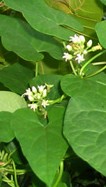 Known by many common names including bluevine, climbing milkweed, sandvine,and smooth swallow-wort, this perennial twining vine is native to central and eastern US where it grows in disturbed areas such as vacant lots and along roadsides, fence rows, and railroad tracks. It grows on fences, other plants, or along the ground. Plants prefer sunny sites and fertile, medium moist soil but tolerate much less. Although valuable as food source for monarch butterfly larvae, honeyvine milkweed is considered an noxious weed in some states.
Known by many common names including bluevine, climbing milkweed, sandvine,and smooth swallow-wort, this perennial twining vine is native to central and eastern US where it grows in disturbed areas such as vacant lots and along roadsides, fence rows, and railroad tracks. It grows on fences, other plants, or along the ground. Plants prefer sunny sites and fertile, medium moist soil but tolerate much less. Although valuable as food source for monarch butterfly larvae, honeyvine milkweed is considered an noxious weed in some states.
Description
 A rhizomateous-taproot root system gives rise to non-woody greenish stems often tinged with red that can grow up to fifteen feet long. The reddish green leaves measure 2.5 by 6 inches, are heart-shaped, opposite, contain milky sap, and are borne on three inch long stems (petioles). Clusters of small honey-scented flowers appear from mid-summer to early fall and are white, often tipped with pink. The fruit is a large green pod that matures to brown. It is three to six inches long and filled with numerous seeds each bearing a tuft of long silky hairs that facilitate wind dispersal. Honeyvine milkweed is often confused with other weeds such as bindweed (Convolvulus arvensis and Calystegia sepium), morning glory (Ipomoea) and buckwheat (Polygonum convolvulus) but can easily be distinguished from them by its clusters of small flowers.
A rhizomateous-taproot root system gives rise to non-woody greenish stems often tinged with red that can grow up to fifteen feet long. The reddish green leaves measure 2.5 by 6 inches, are heart-shaped, opposite, contain milky sap, and are borne on three inch long stems (petioles). Clusters of small honey-scented flowers appear from mid-summer to early fall and are white, often tipped with pink. The fruit is a large green pod that matures to brown. It is three to six inches long and filled with numerous seeds each bearing a tuft of long silky hairs that facilitate wind dispersal. Honeyvine milkweed is often confused with other weeds such as bindweed (Convolvulus arvensis and Calystegia sepium), morning glory (Ipomoea) and buckwheat (Polygonum convolvulus) but can easily be distinguished from them by its clusters of small flowers.
 Control
Control
Control of honeyvine milkweed is very difficult. Not only are the roots difficult to remove from the soil, but also small root fragments left in the soil give rise to new plants. In addition, seed production is high and seed dispersal is wide spread. To further add to the problem is the fact that the vines may grow upward into trees producing seed pods far out of sight and reach. Removing plants as soon as they appear above the soil line is the first line of defense but systemic herbicides such as Roundup may be necessary to totally eradicate the vine.